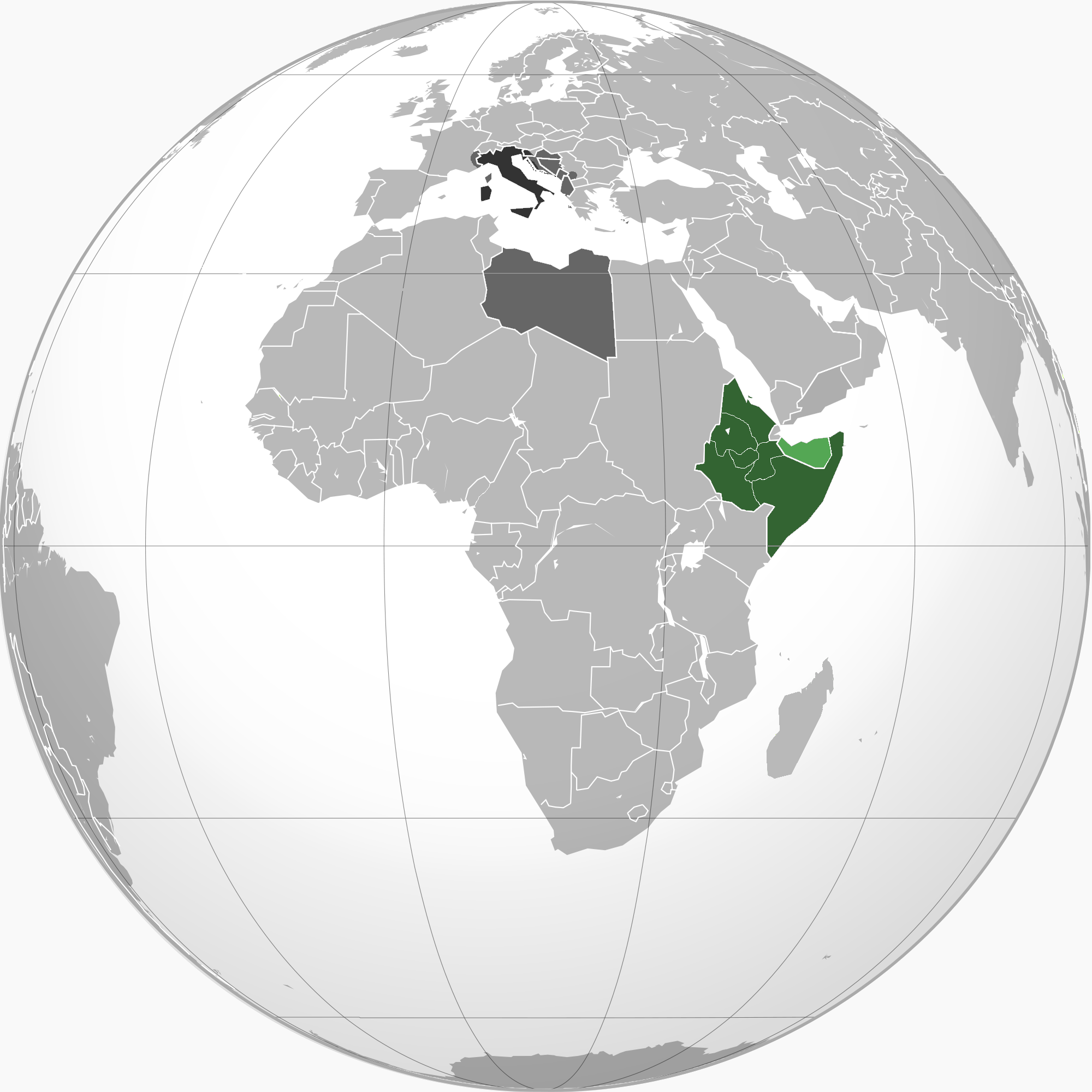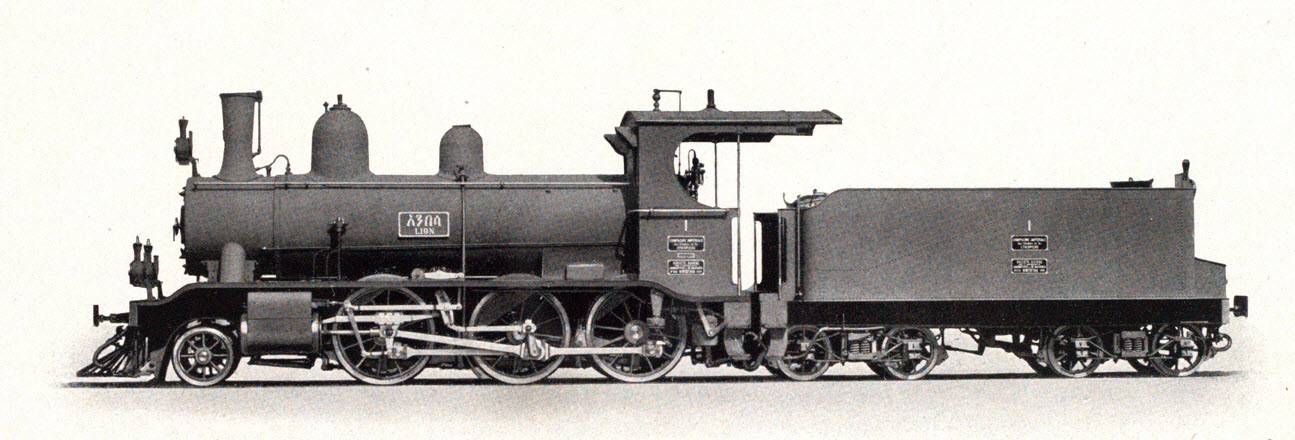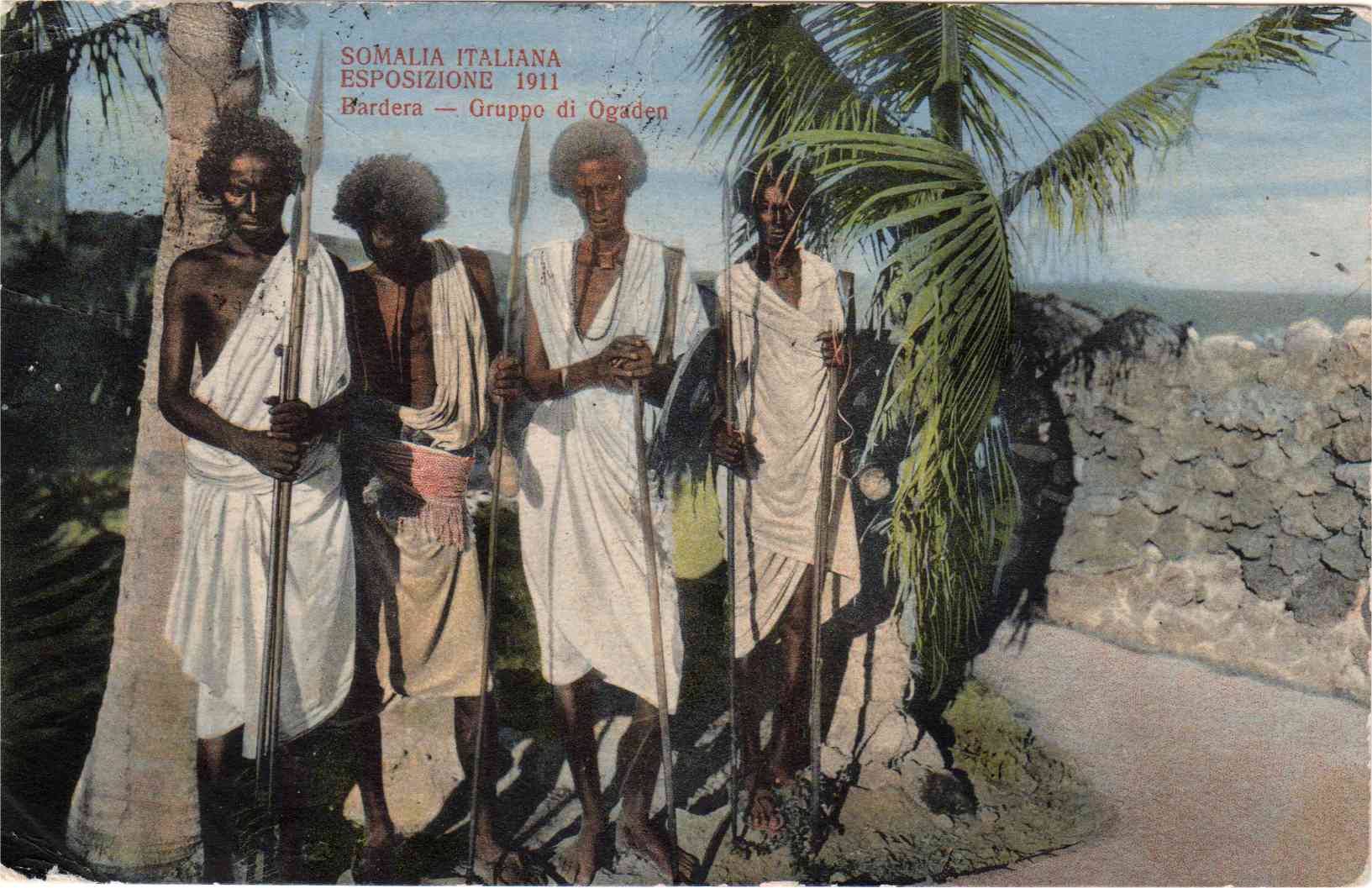|
Somalia Governorate
Somalia Governorate was one of the six governorates of Italian East Africa. It was formed from the previously separate colony of Italian Somalia, enlarged by the Ogaden region of the conquered Ethiopian Empire following the Second Italo-Ethiopian War. History The Somalia Governorate lasted from 1936 until 1941. Its administrative capital was Mogadishu. In 1936, the capital had a population of 50,000 inhabitants, of which nearly 20,000 were Italian Somalis. By 1941, 30,000 Italians lived in Mogadishu, representing around 33% of the city's total 90,000 residents. They frequented local Italian schools that the colonial authorities had opened, such as the "Liceum". The Italian authorities in 1937 began construction of a paved highway from Mogadishu to Addis Ababa, which was completed in 1940. Other roads were started in 1939, from Mogadishu to the northern Somali coast and to the British Kenya Colony to the south. Additionally, there was a project to connect Mogadishu with the Add ... [...More Info...] [...Related Items...] OR: [Wikipedia] [Google] [Baidu] |
Governorates Of Italian East Africa
The Italian colony of Italian East Africa ( it, Africa Orientale Italiana) was composed of six governorates which made up the first level of country subdivisions for the colony. The governorates of Amhara, Galla-Sidamo, Harar and Scioa constituted the " Italian Empire of Ethiopia", which covered about half of the previous Ethiopian Empire. The Eritrea and Somalia Governorates were formed from the previously separate colonies of Italian Eritrea and Somaliland, enlarged with the remainder of Ethiopian territory. The governorates were divided into ''governor commissariats'', governed by a ''governor commissioner'' assisted by a ''vice commissioner''. The commissariats were divided into ''residences'', sometimes divided into ''vice residences''. The governor commissioners were usually also the owners of the ''residence'' with headquarters in the commissariats capital. As a rule, the headquarters of the commissariats were provided with primary schools, post offices and telegraphs ... [...More Info...] [...Related Items...] OR: [Wikipedia] [Google] [Baidu] |
Governorates Of Italian East Africa
The Italian colony of Italian East Africa ( it, Africa Orientale Italiana) was composed of six governorates which made up the first level of country subdivisions for the colony. The governorates of Amhara, Galla-Sidamo, Harar and Scioa constituted the " Italian Empire of Ethiopia", which covered about half of the previous Ethiopian Empire. The Eritrea and Somalia Governorates were formed from the previously separate colonies of Italian Eritrea and Somaliland, enlarged with the remainder of Ethiopian territory. The governorates were divided into ''governor commissariats'', governed by a ''governor commissioner'' assisted by a ''vice commissioner''. The commissariats were divided into ''residences'', sometimes divided into ''vice residences''. The governor commissioners were usually also the owners of the ''residence'' with headquarters in the commissariats capital. As a rule, the headquarters of the commissariats were provided with primary schools, post offices and telegraphs ... [...More Info...] [...Related Items...] OR: [Wikipedia] [Google] [Baidu] |
Kismayo
Kismayo ( so, Kismaayo, Maay Maay, Maay: ''Kismanyy'', ar, كيسمايو, ; it, Chisimaio) is a port city in the southern Lower Juba (Jubbada Hoose) province of Somalia. It is the commercial capital of the autonomous Jubaland region. The city is situated southwest of Mogadishu, near the mouth of the Jubba River, where the waters empty into the Indian Ocean. According to the United Nations Development Programme, the city of Kismayo had a population of around 89,333 in 2005. During the Middle Ages, Kismayo and its surrounding area was part of the Ajuran Empire that governed much of southern Somalia and eastern Ethiopia, with its domain extending from Hobyo in the north, to Kelafo, Qelafo in the west, to Kismayo in the south.Lee V. Cassanelli, ''The shaping of Somali society: reconstructing the history of a pastoral people, 1600–1900'', (University of Pennsylvania Press: 1982), p.102. In the early modern period, Kismayo was ruled by the Geledi Sultanate and by the later 1800 ... [...More Info...] [...Related Items...] OR: [Wikipedia] [Google] [Baidu] |
Ethio-Djibouti Railways
The Ethio-Djibouti Railway (french: Chemin de Fer Djibouto-Éthiopien, C.D.E.; ) is a metre gauge railway in the Horn of Africa that once connected Addis Ababa to the port city of Djibouti. The operating company was also known as the Ethio-Djibouti Railways. The railway was built in 1894–1917 to connect the Ethiopian capital city to French Somaliland. During early operations, it provided landlocked Ethiopia with its only access to the sea. After World War II, the railway progressively fell into a state of disrepair due to competition from road transport. The railway has been mostly superseded by the Addis Ababa–Djibouti Railway, an electrified standard gauge railway that was completed in 2017. The metre gauge railway has been abandoned in central Ethiopia and Djibouti. However, a rehabilitated section is still in operation near the Ethiopia-Djibouti border. As of February 2018, a combined passenger and freight service runs two times a week between the Ethiopian city of ... [...More Info...] [...Related Items...] OR: [Wikipedia] [Google] [Baidu] |
Kenya Colony
The Colony and Protectorate of Kenya, commonly known as British Kenya or British East Africa, was part of the British Empire in Africa. It was established when the former East Africa Protectorate was transformed into a British Crown colony in 1920. Technically, the "Colony of Kenya" referred to the interior lands, while a 16 km (10 mi) coastal strip, nominally on lease from the Sultan of Zanzibar, was the "Protectorate of Kenya", but the two were controlled as a single administrative unit. The colony came to an end in 1963 when an ethnic Kenyan majority government was elected for the first time and eventually declared independence as the Republic of Kenya. History The Colony and Protectorate of Kenya was established on 23 July 1920 when the territories of the former East Africa Protectorate (except those parts of that Protectorate over which His Majesty the Sultan of Zanzibar had sovereignty) were annexed by the UK. The Kenya Protectorate was established on 29 Novembe ... [...More Info...] [...Related Items...] OR: [Wikipedia] [Google] [Baidu] |
Addis Ababa
Addis Ababa (; am, አዲስ አበባ, , new flower ; also known as , lit. "natural spring" in Oromo), is the capital and largest city of Ethiopia. It is also served as major administrative center of the Oromia Region. In the 2007 census, the city's population was estimated to be 2,739,551 inhabitants. Addis Ababa is a highly developed and important cultural, artistic, financial and administrative centre of Ethiopia. Addis Ababa was portrayed in the 15th century as a fortified location called "Barara" that housed the emperors of Ethiopia at the time. Prior to Emperor Dawit II, Barara was completely destroyed during the Ethiopian–Adal War and Oromo expansions. The founding history of Addis Ababa dates back in late 19th-century by Menelik II, Negus of Shewa, in 1886 after finding Mount Entoto unpleasant two years prior. At the time, the city was a resort town; its large mineral spring abundance attracted nobilities of the empire, led them to establish permanent settlement ... [...More Info...] [...Related Items...] OR: [Wikipedia] [Google] [Baidu] |
Italian Somalis
Italian Somalis ( it, Italo-Somali) are Somali descendants from Italian colonists, as well as long-term Italian residents in Somalia. History In 1892, the Italian explorer Luigi Robecchi Bricchetti for the first time labeled as ''Somalia'' the region in the Horn of Africa referred to as '' Benadir''. The area was at the time under the joint control of the Somali Geledi Sultanate (who, also holding sway over the Shebelle region in the interior, was at the height of its power) and the Omani Sultan of Zanzibar. Italian Somaliland In April 1905, the Italian government acquired control (from a private Italian company called ''SACI'') of this coastal area around Mogadishu, and created the colony of Italian Somaliland. From the outset, the Italians signed protectorate agreements with the local Somali authorities.Mariam Arif Gassem, ''Somalia: clan vs. nation'', (s.n.: 2002), p.4 In doing this, the Kingdom of Italy was spared bloody rebellions like those launched by the Dervish ki ... [...More Info...] [...Related Items...] OR: [Wikipedia] [Google] [Baidu] |
Second Italo-Ethiopian War
The Second Italo-Ethiopian War, also referred to as the Second Italo-Abyssinian War, was a war of aggression which was fought between Italy and Ethiopia from October 1935 to February 1937. In Ethiopia it is often referred to simply as the Italian Invasion ( am, ጣልያን ወረራ), and in Italy as the Ethiopian War ( it, Guerra d'Etiopia). It is seen as an example of the expansionist policy that characterized the Axis powers and the ineffectiveness of the League of Nations before the outbreak of the Second World War. On 3 October 1935, two hundred thousand soldiers of the Italian Army commanded by Marshal Emilio De Bono attacked from Eritrea (then an Italian colonial possession) without prior declaration of war. At the same time a minor force under General Rodolfo Graziani attacked from Italian Somalia. On 6 October, Adwa was conquered, a symbolic place for the Italian army because of the defeat at the Battle of Adwa by the Ethiopian army during the First Italo-Ethiopian War ... [...More Info...] [...Related Items...] OR: [Wikipedia] [Google] [Baidu] |
Ethiopian Empire
The Ethiopian Empire (), also formerly known by the exonym Abyssinia, or just simply known as Ethiopia (; Amharic and Tigrinya: ኢትዮጵያ , , Oromo: Itoophiyaa, Somali: Itoobiya, Afar: ''Itiyoophiyaa''), was an empire that historically spanned the geographical area of present-day Ethiopia and Eritrea from the establishment of the Solomonic dynasty by Yekuno Amlak approximately in 1270 until the 1974 coup d'etat of Emperor Haile Selassie by the Derg. By 1896, the Empire incorporated other regions such as Hararghe, Gurage and Wolayita, and saw its largest expansion with the federation of Eritrea in 1952. Throughout much of its existence, it was surrounded by hostile forces in the African Horn; however, it managed to develop and preserve a kingdom based on its ancient form of Christianity. Founded in 1270 by the Solomonic Dynasty nobleman Yekuno Amlak, who claimed to descend from the last Aksumite king and ultimately the Biblical Menelik I and the Queen of Sheba, i ... [...More Info...] [...Related Items...] OR: [Wikipedia] [Google] [Baidu] |
Ogaden
Ogaden (pronounced and often spelled ''Ogadēn''; so, Ogaadeen, am, ውጋዴ/ውጋዴን) is one of the historical names given to the modern Somali Region, the territory comprising the eastern portion of Ethiopia formerly part of the Hararghe province. The other two names are the Haud and Reserved area. Etymology The origin of the term ''Ogaden'' is unknown, however it is usually attributed to the Somali clan of the same name, originally referring only to their land, and eventually expanding to encompass most parts of the modern Somali Region of Ethiopia. During the new region's founding conference, which was held in Dire Dawa in 1992, the naming of the region became a divisive issue, because almost 30 Somali clans live in the Somali Region of Ethiopia. The ONLF sought to name the region ‘Ogadenia’, whilst the non-Ogadeni Somali clans who live in the same region opposed this move. As noted by Abdul Majid Hussein, the naming of the region where there are several Somal ... [...More Info...] [...Related Items...] OR: [Wikipedia] [Google] [Baidu] |
Italian Somalia
Italian Somalia ( it, Somalia Italiana; ar, الصومال الإيطالي, Al-Sumal Al-Italiy; so, Dhulka Talyaaniga ee Soomaalida), was a protectorate and later colony of the Kingdom of Italy in present-day Somalia. Ruled in the 19th century by the Somali Sultanates of Hobyo and Majeerteen in the north, and the Hiraab Imamate and Geledi Sultanate and the Biimaal Sultanate leading a resistance against the colonials in southern Somalia for decades. The territory was acquired in the 1880s by Italy through various treaties.Mariam Arif Gassem, ''Somalia: clan vs. nation'' (s.n.: 2002), p.4 In 1936, the region was integrated into Italian East Africa as the Somalia Governorate. This would last until Italy's loss of the region in 1941, during the East African campaign of World War II. Italian Somalia then came under British military administration until 1950, when it became a United Nations trusteeship, the Trust Territory of Somalia under Italian administration. On 1 July 196 ... [...More Info...] [...Related Items...] OR: [Wikipedia] [Google] [Baidu] |
Carlo De Simone
Carlo De Simone (4 March 1885 – 1951) was an officer in the Italian Army during World War II. Biography During most of the East African Campaign, Lieutenant-General De Simone commanded Italian forces in southern Italian Somaliland. However, during the Italian invasion of British Somaliland, De Simone commanded General Guglielmo Nasi's main "center" column. De Simone's command in Italian Somaliland included the reinforced Harar Division (XIII Colonial Brigade, XIV Colonial Brigade, and XV Colonial Brigade - amounting to eleven infantry battalions, fourteen batteries of artillery, a company of medium tanks (12 tanks), a squadron of light tanks (4 light tanks), and an armored car company (12 armored cars). Whilst in command of these forces, De Simone won the Battle of Tug Argan, where his center column overcame a smaller British army and forced them to evacuate. Command history * Commanding Officer, 3rd Bersaglieri Regiment * Governor of Harar, Italian East Africa - 1936 * ... [...More Info...] [...Related Items...] OR: [Wikipedia] [Google] [Baidu] |





.jpg)

